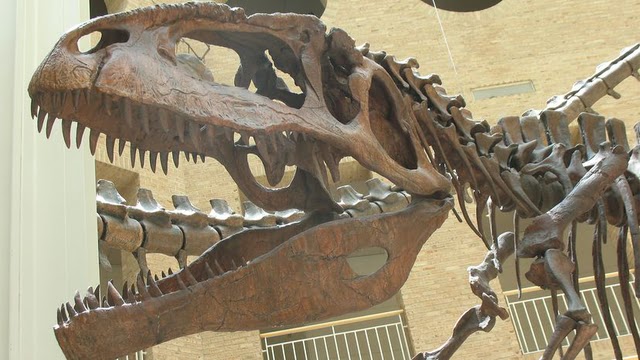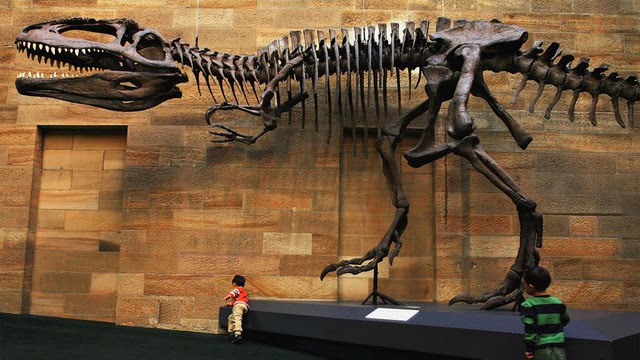Quck answer
Giganotosaurus was a massive carnivorous dinosaur that lived during the Late Cretaceous period. It was one of the largest predators to ever roam the Earth, measuring up to 43 feet in length and weighing up to 8 tons. The Giganotosaurus had a long, narrow skull with sharp teeth and powerful jaws, making it a fearsome hunter. It is believed to have preyed on large herbivorous dinosaurs like the Argentinosaurus. Despite its size and strength, the Giganotosaurus went extinct along with the rest of the dinosaurs at the end of the Cretaceous period.
Extinct Animals

The Fernbank Museum of Natural History in Atlanta, Georgia displays the skeleton of Giganotosaurus carolinii. James Emery/Flickr (CC BY 2.0)
Despite never living on the same continent and existing 30 million years apart, Giganotosaurus carolinii is often compared to the world’s most famous dinosaur, Tyrannosaurus rex.
Tyrannosaurus rex has been a media sensation since 1906, when The New York Times dubbed it “the prize fighter of antiquity.” T. rex was already a star attraction at the American Museum of Natural History in Manhattan, just one year after its discovery.
Now, we know that an adult T. rex could stand 12 feet tall (3.6 meters) at the hip and measure 40 feet (12 meters) long, making it one of the largest predators ever to roam the earth.
However, a few other carnivorous dinosaurs may have been just as large or even bigger than T. rex. Giganotosaurus is one of these elite predators, and it is part of a dinosaur mystery that remains unsolved.
The Beasts of the Southern Wild
T. rex and Giganotosaurus both belong to the theropoda clade, which is a group of organisms that includes a common ancestor species and all of its presumed descendants. Hollow-boned and bipedal, theropods are still a highly successful group today. Every carnivorous dinosaur that has been discovered, as well as many plant-eating species and all birds, living and extinct, can be found in the documented theropod list.
The last nonavian dinosaurs existed during the Cretaceous period, which lasted from 145 to 66 million years ago. The end of this period marked the end of the Mesozoic Era, which is also known as “The Age of Dinosaurs.”
Tyrannosaurus rex lived in North America during the end of the Cretaceous period, making its debut around 68 million years ago. Giganotosaurus, on the other hand, was a product of a different time and landmass.

The Australian Museum in Sydney displays a reconstructed Giganotosaurus carolinii skeleton. Lisa Maree Williams/Getty Images
Giganotosaurus was native to western Argentina and lived during the early Cretaceous period, roughly 98 to 97 million years ago. During this time, South America was a land of giants. Huge sauropods, or “long-necked dinosaurs,” roamed the area, with some species stretching around 50 feet (15 meters) long, such as Andesaurus and Limayasaurus. The local bestiary also included crocodylians, early snakes, and beaked herbivores.
Giganotosaurus must have kept its neighbors on guard. Paleontologists Rodolfo A. Coria and Leonardo Salgado first announced the discovery of this theropod in 1995. However, we still have not found a complete skeleton. The backbones and tail vertebrae we have suggest that Giganotosaurus was at least 41 feet (12.5 meters) long.
Therefore, Giganotosaurus might have been slightly longer than Tyrannosaurus rex.
However, a 2014 paper published in the journal Plos Biology argued that T. rex had a much heavier build. Using the circumference of its upper leg bone, Roger Benson and his colleagues calculated that a mature Giganotosaurus weighed about 13,448 pounds (6,100 kilograms), while T. rex weighed a whopping 16,975 pounds (7,700 kilograms).
Shark-like Teeth Sliced Ribbons of Flesh off Prey
Weight differences aside, the jaws of these two carnivores tell different tales. Anatomical evidence suggests that T. rex and Giganotosaurus used very different methods to take down their prey.
The teeth of Tyrannosaurus were thick and banana-shaped, perfect for crushing bones, while Giganotosaurus had tall and skinny teeth that resembled recurved kitchen knives. These teeth were serrated on both sides and were housed inside a narrow snout. Giganotosaurus had a monstrous skull that was estimated to be around 6 feet (2 meters) long. Experts believe that Giganotosaurus probably killed by slicing ribbons of meat off its prey, rather than shattering bones. Victims may have bled out while the carnivore waited nearby. Giganotosaurus belonged to the carcharodontosaurids, one of the most intimidating families in the fossil record. This family was named after the great white shark, Carcharodon carcharias, as the word “carcharodontosaurid” roughly translates to “shark-toothed lizard” in Greek. Carcharodontosaurids were giant meat-eating dinosaurs with deep jaws and sharp, thin, almost shark-like teeth. They were the largest and most formidable predators in many ecosystems during the early to middle part of the Cretaceous Period, before the rise of tyrannosaurs. T. rex had smaller ancestors, and it wasn’t until the mighty carcharodontosaurids died out that giant tyrannosaurs started evolving. This changeover remains a mystery in dinosaur evolution. Spinosaurus aegyptiacus, an African dinosaur, had a weird, paddle-shaped tail and a length of about 47 feet (over 14 meters).
FAQ
1. What is Giganotosaurus?
Giganotosaurus is a genus of theropod dinosaur that lived during the Late Cretaceous Period, about 98 to 97 million years ago. It was one of the largest carnivorous dinosaurs that ever lived, and it is known from fragmentary fossils found in Argentina. The name Giganotosaurus means “giant southern lizard” in Greek.
2. How big was Giganotosaurus?
Giganotosaurus was estimated to be about 12 to 13 meters (39 to 43 feet) long and weighed around 6 to 13 tons. It had a long, slender skull with sharp teeth, and its body was supported by powerful hind limbs. Its arms were relatively short and had three-fingered hands.
3. What did Giganotosaurus eat?
As a carnivorous dinosaur, Giganotosaurus likely preyed on other large dinosaurs, such as sauropods and ornithopods. Its sharp teeth and powerful jaws would have allowed it to tear through flesh and bone with ease. Some researchers also suggest that Giganotosaurus may have been a scavenger, feeding on the carcasses of dead animals.
4. How was Giganotosaurus different from T. rex?
Giganotosaurus and Tyrannosaurus rex were both large carnivorous dinosaurs that lived during the Late Cretaceous Period, but they had some key differences. Giganotosaurus was slightly larger than T. rex and had a longer and more slender skull. Its teeth were also more curved and serrated. Additionally, Giganotosaurus had longer arms with three-fingered hands, while T. rex had shorter arms with two-fingered hands.
5. Where and when were Giganotosaurus fossils discovered?
The first Giganotosaurus fossils were discovered in 1993 by an amateur paleontologist named RubГ©n Dario Carolini in the Patagonia region of Argentina. The fossils consisted of a partial skull and skeleton, along with some isolated bones. Since then, several other partial skeletons and isolated bones have been found in the same region, dating to the Late Cretaceous Period.
6. What can we learn from studying Giganotosaurus?
Studying Giganotosaurus and other large carnivorous dinosaurs can tell us a lot about the ecology and evolution of prehistoric ecosystems. By examining their anatomy and behavior, researchers can gain insights into how they hunted, interacted with other animals, and adapted to changes in their environment. Additionally, studying Giganotosaurus and other dinosaurs can help us better understand the history of life on Earth and the processes that shaped it.





Leave a Reply